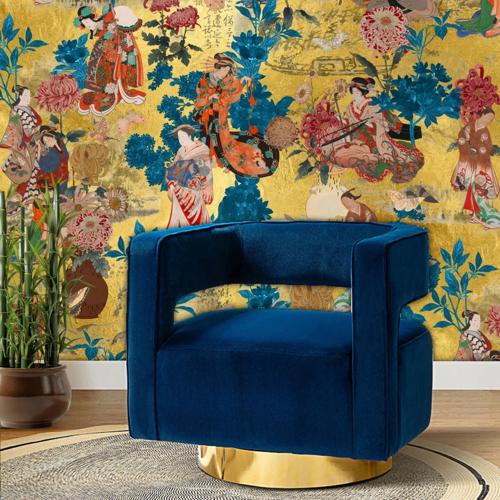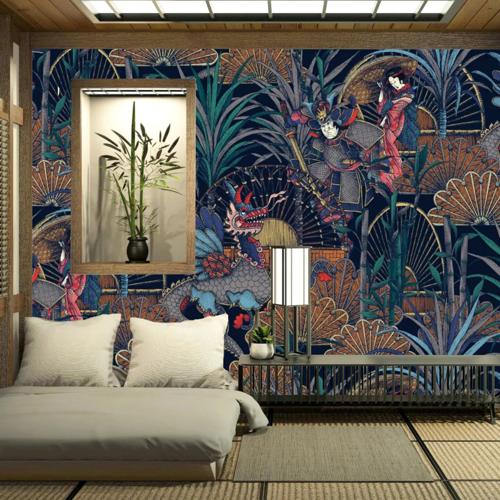When we mention Oriental wallpapers, we are really talking about a design tradition that stretches back centuries. These wallpapers bring together the rich artistic styles of Asia, often featuring detailed patterns, elegant florals and symbolic motifs. From delicate cranes and cherry blossoms to sweeping landscapes and ornate fans, Oriental wallpapers offer a way to introduce culture, history and artistry into a modern home.

‘Ikagai’ by ModEco Home - Showing how a modern space can be transformed with the right Oriental wallpaper.
What makes them so appealing today is their versatility. Some people lean toward softer, more traditional looks, while others prefer bold interpretations that feel more contemporary. Whether you’re drawn to the calm of Japanese wallpapers or the drama of Chinoiserie wallpapers, Oriental-inspired designs give your walls personality and depth that paint alone cannot achieve.
Japanese Wallpapers – A brief history
Japanese wallpapers have their roots in centuries-old craft traditions. The influence of Japanese art can be traced to screens, woodblock prints and textiles that date back hundreds of years. Early Japanese design often celebrated nature, focusing on cherry blossoms, flowing water and seasonal changes. These motifs carried deep symbolic meaning, representing beauty and renewal. They showed harmony between humans and the natural world.
When wallpaper production spread globally in the 18th and 19th centuries, Japanese aesthetics quickly captured the imagination of Western designers. Delicate line work, minimalist balance and themes drawn from nature stood in sharp contrast to the heavier European styles of the time. By the early 20th century, Japanese wallpapers had become part of a wider design conversation, influencing everything from textiles to architecture. Today, these designs are prized not only for their beauty but also for the sense of calm and order they bring to interiors, whether Western or traditional.
How do Japanese style wallpapers work with Western interior design?
It might seem strange and surprising that Japanese style wallpapers seem to fit so seamlessly into Western interiors, but the truth is they do. This is because they adapt beautifully. The clean lines, natural motifs and understated elegance of Japanese design work particularly well in modern homes, where simplicity and balance are more important.
Take for example a soft cherry blossom print. It can add warmth and serenity to a bedroom, while a bolder wave or mountain scene can transform a living room feature wall into a piece of art. In minimalist or Scandinavian-inspired spaces, Japanese wallpapers provide just enough detail to create interest without overwhelming the room.
They also pair well with natural materials like wood, linen and stone which are common in both Japanese and Western design. This shared appreciation for organic textures makes it easy to blend the two styles. The result is an interior that feels thoughtful, calming and visually balanced.

Showcasing a more traditional space with ‘Japanese Rattan’ by ModEco Home
Chinoiserie vs Japanese – What are the differences?
When discussing Oriental wallpapers, people often confuse Chinoiserie wallpapers with Japanese-inspired designs. While both draw on Asian aesthetics, they are quite distinctly different.
Chinoiserie emerged in Europe in the 17th and 18th centuries, as Western designers created their own interpretations of Chinese art and culture. Chinoiserie wallpapers often feature fantastical scenes with pagodas, exotic birds, dragons and winding floral patterns. They are ornate, playful and sometimes romanticized, reflecting how Europeans imagined the Far East rather than accurately depicting it.
'Pearl of Hei Shan' is a tribute to the timeless beauty of antique Chinese lacquered screens by ModEco Home
Japanese wallpapers, on the other hand, come directly from Japan’s own artistic traditions. They tend to focus more on nature and balance, with motifs such as koi fish, cherry blossoms, bamboo or cranes. Where chinoiserie can feel whimsical and decorative, Japanese-style wallpapers often feel more meditative and restrained.
Modern Japanese wallpapers have definitely evolved and are much more diverse in style and vibrancy than the traditional designs of the past. While traditional Japanese wallpaper (like hand-painted folding screens or prints) tends to favor subtlety and calm, contemporary Japanese wallpaper often blends old traditions with modern, bold, and graphic patterns, think rich blues, reds, and even neon hues.
The beauty of Oriental wallpapers lies in their range. Whether you’re drawn to the storytelling and detail of chinoiserie wallpapers or the quiet strength of Japanese style wallpapers, both bring history and artistry into the home. They also adapt surprisingly well to modern interiors, proving that these centuries-old traditions still resonate today.
When you choose a wallpaper rooted in these styles, you’re not just decorating a wall, you are bringing a cultural legacy into your space. That’s what makes Oriental wallpapers timeless: they connect past and present while giving every room a story of its own.







(0) comments
We welcome your comments
Log In
Post a comment as Guest
Keep it Clean. Please avoid obscene, vulgar, lewd, racist or sexually-oriented language.
PLEASE TURN OFF YOUR CAPS LOCK.
Don't Threaten. Threats of harming another person will not be tolerated.
Be Truthful. Don't knowingly lie about anyone or anything.
Be Nice. No racism, sexism or any sort of -ism that is degrading to another person.
Be Proactive. Use the 'Report' link on each comment to let us know of abusive posts.
Share with Us. We'd love to hear eyewitness accounts, the history behind an article.